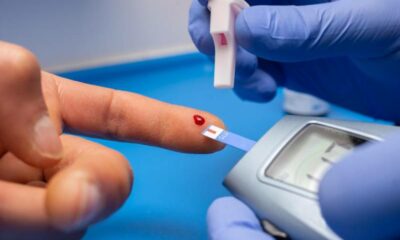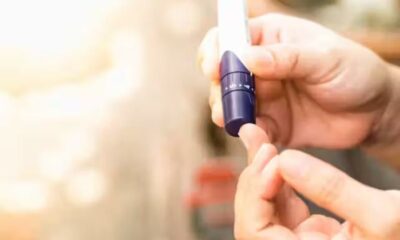Living with diabetes can be a constant source of stress. From monitoring blood sugar levels to managing medications and making lifestyle changes, the demands of this chronic condition can take a toll on mental and physical health. Stress can have a significant impact on blood sugar levels, creating a challenging cycle for diabetics. Effective stress management is crucial for maintaining overall well-being and achieving better blood sugar control. This article explores various relaxation techniques and practices that can help diabetics manage stress and improve their quality of life.
Understanding the Link Between Stress and Diabetes
The Physiological Impact of Stress
When the body experiences stress, it releases hormones such as cortisol and adrenaline. These hormones trigger a “fight or flight” response, increasing heart rate, blood pressure, and blood sugar levels. For diabetics, this stress-induced spike in blood sugar can complicate diabetes management and increase the risk of complications.
Psychological Effects of Chronic Stress
Chronic stress can lead to mental health issues such as anxiety and depression, which can negatively impact diabetes management. Stress can cause emotional eating, neglect of diabetes care routines, and poor decision-making, all of which can worsen blood sugar control.
The Vicious Cycle of Stress and Diabetes
The relationship between stress and diabetes is bidirectional. Stress can lead to poor diabetes management, and unmanaged diabetes can lead to increased stress. Breaking this cycle is essential for effective diabetes management and overall health.
Traditional Stress Management Techniques
Physical Activity
Regular physical activity is one of the most effective ways to manage stress and improve blood sugar control. Exercise releases endorphins, which are natural mood elevators, and helps reduce stress hormones.
- Benefits: Reduces stress hormones, improves mood, enhances insulin sensitivity, and supports weight management.
- Types of Activities: Walking, jogging, swimming, cycling, yoga, and strength training. Aim for at least 150 minutes of moderate aerobic activity or 75 minutes of vigorous activity per week, along with muscle-strengthening activities on two or more days per week.
Healthy Eating
A balanced diet plays a crucial role in managing both stress and diabetes. Certain foods can help reduce stress and stabilize blood sugar levels.
- Stress-Reducing Foods: Foods rich in omega-3 fatty acids (such as salmon and flaxseeds), magnesium (such as leafy greens and nuts), and antioxidants (such as berries and dark chocolate).
- Balanced Diet: Focus on whole foods, including plenty of fruits, vegetables, whole grains, lean proteins, and healthy fats. Avoid excessive caffeine, sugar, and processed foods, which can exacerbate stress and blood sugar fluctuations.
Adequate Sleep
Sleep is essential for stress management and blood sugar regulation. Lack of sleep can increase stress hormones and insulin resistance, making blood sugar control more difficult.
- Improving Sleep Hygiene: Establish a regular sleep schedule, create a relaxing bedtime routine, and ensure your sleep environment is comfortable and free from distractions. Aim for 7-9 hours of sleep per night.
Social Support
Strong social support can help buffer the effects of stress and improve overall well-being.
- Role of Social Support: Friends, family, and support groups can provide emotional support, practical advice, and motivation. They can also help you stay accountable for your diabetes management.
- Building a Support Network: Join local or online diabetes support groups, participate in community activities, and communicate regularly with loved ones.
Mindfulness and Meditation Practices
Mindfulness Meditation
Mindfulness meditation involves focusing on the present moment without judgment. It can help reduce stress by promoting relaxation and enhancing self-awareness.
- Benefits: Lowers stress hormones, improves mood, and enhances overall well-being. It can also help improve focus and reduce anxiety.
- How to Practice: Find a quiet place, sit comfortably, and focus on your breath. Notice the sensations of breathing and gently bring your attention back whenever your mind wanders. Start with a few minutes each day and gradually increase the duration.
Guided Imagery
Guided imagery involves visualizing peaceful and calming scenes to promote relaxation.
- Benefits: Helps reduce stress and anxiety, promotes relaxation, and can improve mood and sleep.
- How to Practice: Find a quiet place, close your eyes, and imagine a peaceful scene, such as a beach or forest. Focus on the details of the scene and allow yourself to fully immerse in the experience. Guided imagery recordings can also be helpful.
Body Scan Meditation
Body scan meditation involves focusing attention on different parts of the body to promote relaxation and mindfulness.
- Benefits: Helps reduce stress and anxiety, promotes relaxation, and increases body awareness.
- How to Practice: Lie down or sit comfortably, close your eyes, and bring your attention to your toes. Slowly move your focus up through your body, noticing any sensations without judgment. Take your time with each body part, and practice regularly for best results.
Breathing Techniques
Deep Breathing Exercises
Deep breathing exercises can help activate the body’s relaxation response and reduce stress.
- Benefits: Lowers stress hormones, reduces anxiety, and promotes relaxation.
- How to Practice: Sit or lie down comfortably, place one hand on your chest and the other on your abdomen. Take a slow, deep breath in through your nose, allowing your abdomen to rise. Exhale slowly through your mouth, feeling your abdomen fall. Repeat for several minutes.
Progressive Muscle Relaxation
Progressive muscle relaxation involves tensing and then relaxing different muscle groups to reduce stress.
- Benefits: Reduces muscle tension, lowers stress hormones, and promotes relaxation.
- How to Practice: Find a quiet place, sit or lie down comfortably, and close your eyes. Starting with your toes, tense the muscles for a few seconds, then release and relax. Move up through your body, tensing and relaxing each muscle group. Practice regularly for best results.
Alternate Nostril Breathing
Alternate nostril breathing is a yoga breathing technique that can help balance the nervous system and reduce stress.
- Benefits: Lowers stress hormones, promotes relaxation, and improves focus and mental clarity.
- How to Practice: Sit comfortably, close your right nostril with your thumb, and inhale slowly through your left nostril. Close your left nostril with your ring finger, release your right nostril, and exhale slowly through your right nostril. Inhale through your right nostril, close it with your thumb, release your left nostril, and exhale through your left nostril. Repeat for several minutes.
Cognitive Behavioral Strategies
Cognitive Restructuring
Cognitive restructuring involves identifying and challenging negative thought patterns to reduce stress.
- Benefits: Helps manage stress and anxiety, improves mood, and promotes positive thinking.
- How to Practice: Identify negative thoughts and beliefs that contribute to stress. Challenge these thoughts by considering alternative perspectives and evidence. Replace negative thoughts with more balanced and positive ones.
Problem-Solving Skills
Effective problem-solving skills can help manage stress by addressing and resolving stressful situations.
- Benefits: Reduces stress and anxiety, improves coping skills, and enhances overall well-being.
- How to Practice: Identify the problem, brainstorm potential solutions, evaluate the pros and cons of each solution, choose the best option, and implement it. Review the outcome and adjust if necessary.
Time Management
Good time management can help reduce stress by making it easier to balance responsibilities and avoid feeling overwhelmed.
- Benefits: Reduces stress and anxiety, improves productivity, and enhances overall well-being.
- How to Practice: Prioritize tasks, set realistic goals, break tasks into smaller steps, and create a schedule. Avoid procrastination and practice self-discipline. Use tools such as planners and apps to stay organized.
Incorporating Relaxation Techniques into Daily Life
Creating a Stress-Reduction Plan
Developing a personalized stress-reduction plan can help integrate relaxation techniques into daily life.
- Benefits: Provides structure and consistency, helps manage stress more effectively, and promotes overall well-being.
- How to Create a Plan: Identify stressors and relaxation techniques that work for you. Set realistic goals and create a schedule for practicing these techniques. Monitor your progress and adjust your plan as needed.
Setting Realistic Goals
Setting achievable goals for stress management can help maintain motivation and ensure success.
- Benefits: Reduces stress and anxiety, improves focus and motivation, and enhances overall well-being.
- How to Set Goals: Use the SMART criteria (Specific, Measurable, Achievable, Relevant, Time-bound) to set realistic and achievable goals. Break larger goals into smaller steps and celebrate your progress.
Regular Practice and Consistency
Consistency is key for effective stress management. Regular practice of relaxation techniques can help make them a natural part of your routine.
- Benefits: Enhances the effectiveness of relaxation techniques, promotes long-term stress reduction, and improves overall well-being.
- Tips for Consistency: Set aside dedicated time each day for relaxation techniques, integrate them into your daily routine, and use reminders or alarms to stay on track. Practice patience and persistence, as it can take time to see the benefits.
Alternative and Complementary Therapies
Acupuncture
Acupuncture is a traditional Chinese medicine practice that involves inserting thin needles into specific points on the body to promote healing and relaxation.
- Benefits: Reduces stress and anxiety, improves mood, and enhances overall well-being. Some studies suggest it can also improve blood sugar control.
- How to Try Acupuncture: Find a licensed and experienced acupuncturist. Discuss your health history and concerns, and follow the recommended treatment plan. Be open to multiple sessions for the best results.
Aromatherapy
Aromatherapy involves using essential oils to promote relaxation and well-being.
- Benefits: Reduces stress and anxiety, improves mood, and promotes relaxation. Some essential oils may also have specific health benefits.
- Popular Essential Oils: Lavender, chamomile, bergamot, and ylang-ylang are commonly used for stress relief. Use essential oils in a diffuser, add them to a bath, or apply them to the skin (diluted with a carrier oil).
Massage Therapy
Massage therapy involves manipulating the body’s soft tissues to promote relaxation and well-being.
- Benefits: Reduces muscle tension, lowers stress hormones, improves mood, and enhances overall well-being.
- Types of Massage: Swedish massage, deep tissue massage, and aromatherapy massage are popular options for stress relief. Find a licensed and experienced massage therapist, and communicate your preferences and any health concerns.
Real-Life Success Stories and Case Studies
Profiles of Diabetics Who Have Successfully Managed Stress
Sharing real-life success stories can provide inspiration and practical insights into stress management for diabetics.
- Case Studies: Highlight individuals who have successfully managed stress and diabetes through various relaxation techniques and practices. Share their strategies, challenges, and outcomes.
- Key Takeaways: Summarize the main lessons from these success stories and provide practical tips that readers can apply to their own lives.
Innovative Programs and Initiatives
Community programs and initiatives can provide valuable support and resources for stress management.
- Examples of Programs: Highlight programs and initiatives that have helped diabetics manage stress effectively. Include information on their structure, activities, and impact on participants.
- Notable Success Stories: Share examples of programs that have made a significant difference in the lives of individuals with diabetes. Highlight the strategies and practices that contributed to their success.
Conclusion
Summary of Key Points
Effective stress management is crucial for diabetics to maintain both physical and mental health. Various relaxation techniques and practices, such as physical activity, healthy eating, adequate sleep, social support, mindfulness and meditation practices, breathing techniques, cognitive behavioral strategies, and alternative therapies, can help reduce stress and improve overall well-being.

 Diabetology2 weeks ago
Diabetology2 weeks ago
 Diabetology2 weeks ago
Diabetology2 weeks ago
 Diabetology2 weeks ago
Diabetology2 weeks ago
 Diabetology1 week ago
Diabetology1 week ago
 Diabetology2 days ago
Diabetology2 days ago
 Diabetology1 day ago
Diabetology1 day ago
 Diabetology1 day ago
Diabetology1 day ago











